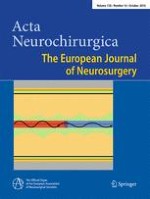Published in:

01-10-2016 | Clinical Article - Functional
Electrophysiological interpretations of the clinical response to stimulation parameters of pallidal deep brain stimulation for cervical dystonia
Authors:
Ryoong Huh, Moonyoung Chung
Published in:
Acta Neurochirurgica
|
Issue 10/2016
Login to get access
Abstract
Objective
Deep brain stimulation (DBS) at the posterolateral ventral portion of the globus pallidus internus (GPi) has been regarded as a good therapeutic modality. Because the theoretical principle behind the stimulation parameters is yet to be determined, this study aimed to interpret analyses of the stimulation parameters used in our department based on an electrophysiological review.
Methods
Nineteen patients with medically refractory idiopathic cervical dystonia who underwent GPi DBS were enrolled. The baseline and follow-up parameters were analyzed according to their dependence on time after DBS. The pattern of changes in the stimulation parameters over time, the differences across the four active contacts, and the relationship between the stimulation parameters and clinical benefits were evaluated.
Results
Mean age and disease duration were 50.9 years and 54.7 months, respectively. Mean follow-up duration was 22.6 months. The amplitude and frequency exhibited significant increasing temporal patterns, i.e., a mean amplitude and frequency of 3.1 V and 132.2 Hz at the initial setting and 4.0 V and 142.6 Hz at the last follow-up, respectively. The better clinical response group (clinical improvement rate of 65–100 %) used a narrower pulse width (mean value of 78.4 μs) than the worse clinical response group (clinical improvement rate of 5–60 %, mean of value of 88.6 μs). Active contact at the GPe was used more often in the worse clinical response group than in the better response group.
Conclusions
Based on electrophysiological considerations, these patterns of stimulation parameters could be interpreted. This interpretation was based on a theoretical understanding of the mechanisms of action of DBS, i.e., that the abnormal neural signal is substituted by an induced neural signal, which is generated by therapeutic DBS.





